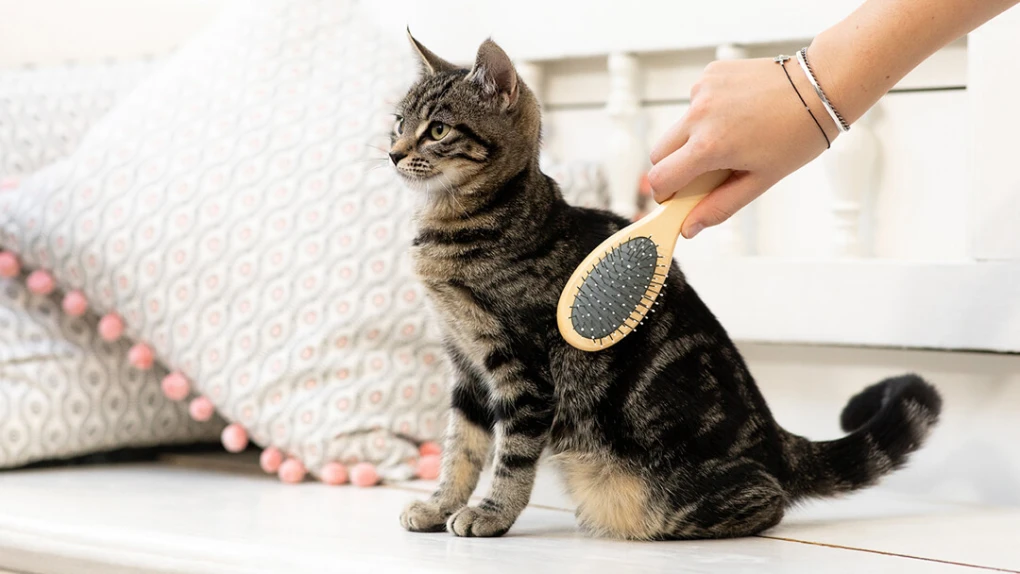Kitten Grooming 101: How to Get Your Cat Used to Grooming

Regular grooming is important for your kitten's health and bonding with you. But it takes patience to get kittens accustomed to being handled and brushed. Use this step-by-step guide to positively introduce your kitten to grooming routines.
Why Groom Kittens?
Grooming benefits kittens in the following ways:
- Removes loose hair and reduces shedding around your home
- Distributes natural oils across the coat for shine and skin health
- Helps prevent mats, knots, and felting of the fur
- Allows inspection for parasites, skin issues, wounds, or other problems
- Strengthens socialization and trust in being handled
- Provides mental stimulation and relaxing bonding time
Starting grooming routines early prevents sensitivities and makes it easier compared to introducing grooming to an adult cat. But it must be done gradually and positively.
Choose Appropriate Grooming Tools
Using the right kitten grooming supplies gets the job done while preventing stress or injury:
- Slicker brush - Fine wire bristles remove loose undercoat. Use gentle pressure.
- Comb - Wide-toothed combs smooth and detangle longer fur.
- Kitten shampoo - Gentle shampoos made for kittens when bathing.
- Nail clippers - Clip nail tips carefully to avoid the quick.
- Toothbrush - Soft bristles and cat toothpaste for dental care.
- Ear cleaner - To gently remove wax using cotton balls.
Introduce each type of tool slowly so your kitten feels comfortable with all aspects of grooming.
Step-by-Step Guide to Handling and Brushing
Here are step-by-step tips for getting your kitten used to being handled and brushed:
1. Start Young
Begin grooming as early as 6-8 weeks old when adopting a new kitten. Early positive experiences prevent sensitivity.
2. Short, Frequent Sessions
Daily short 1-2 minute handling and brushing sessions are ideal. Set a routine time when kitten is relaxed.
3. Offer Treats and Praise
Make sessions positive by offering treats, petting, and calm praise. Stop immediately if kitten seems distressed.
4. Handle All Areas
Gently touch kitten's paws, ears, mouth, tail, and belly regularly so they become desensitized.
5. Use a Soft Slicker Brush
Lightly brush while petting with your other hand. Just do a few strokes per area.
6. Increase Duration
Build up over multiple weeks to longer 5-10 minute brushing sessions as kitten relaxes into the process.
7. Keep It Pleasant
Stay calm, gentle and reassuring. End on a good note. Don't overdo handling or restraint.
Regular short positive grooming experiences now means a lifetime of easier grooming for your cat!
Introducing the Nail Trim
Trimming kitten nails regularly prevents scratches and helps acclimate them to handling their feet:
- Gently hold paw and extend the toe pad to expose each nail. Only trim the sharp tip.
- Use cat-specific clippers suited for small nails. Cut below the quick (pink tissue inside nail).
- Just do 1-2 nails per session initially. Offer a treat after clipping each nail.
- As kitten remains relaxed, build up to doing all nails in one session.
- Praise kitten during the process and give an extra treat when finished.
- Stop immediately if kitten seems scared or struggles excessively. Try again later.
Daily touching their feet and exposing nails followed by occasional clipped gets kittens comfortable with nail trims.
Bathing Your Kitten
While kittens rarely need full baths, introducing water and bathing teaches them to tolerate handling:
- Place kitten in a sink lined with a non-slip mat for baths. Use lukewarm water.
- Wet their coat with a detachable sprayer or plastic cup. Avoid getting water in ears and eyes.
- Apply a tiny amount of kitten shampoo, lather, then immediately rinse clean.
- Dry thoroughly with an absorbent towel, then towel dry or use a pet hair dryer on low heat.
- Offer treats and cuddles throughout so they associate bath time with good things.
- Start with quick 15-30 second baths. As kitten relaxes, gradually increase to 1-2 minute baths.
Frequent short, calm baths accustom kittens to the process for easier hygiene down the road.
Additional Tips for Pleasant Grooming
Here are some extra tips to help grooming go smoothly:
- Start sessions when kitten is already relaxed after playtime or a meal
- Ensure grooming supplies are easily accessible so you don't have to disrupt the process
- Give kitten a special grooming treat they only receive during or after sessions
- Try different types of cat-specific brushes and combs to find their preference
- Offer catnip spray lightly on brushes or toys to encourage enjoyment
- Ensure all experiences are calm and non-threatening
- Discontinue immediately if kitten exhibits signs of fear like dilated pupils, crouching, biting or scratching
Grooming time done right strengthens the bond with your kitten and establishes healthy lifelong habits. Be patient and keep it positive!